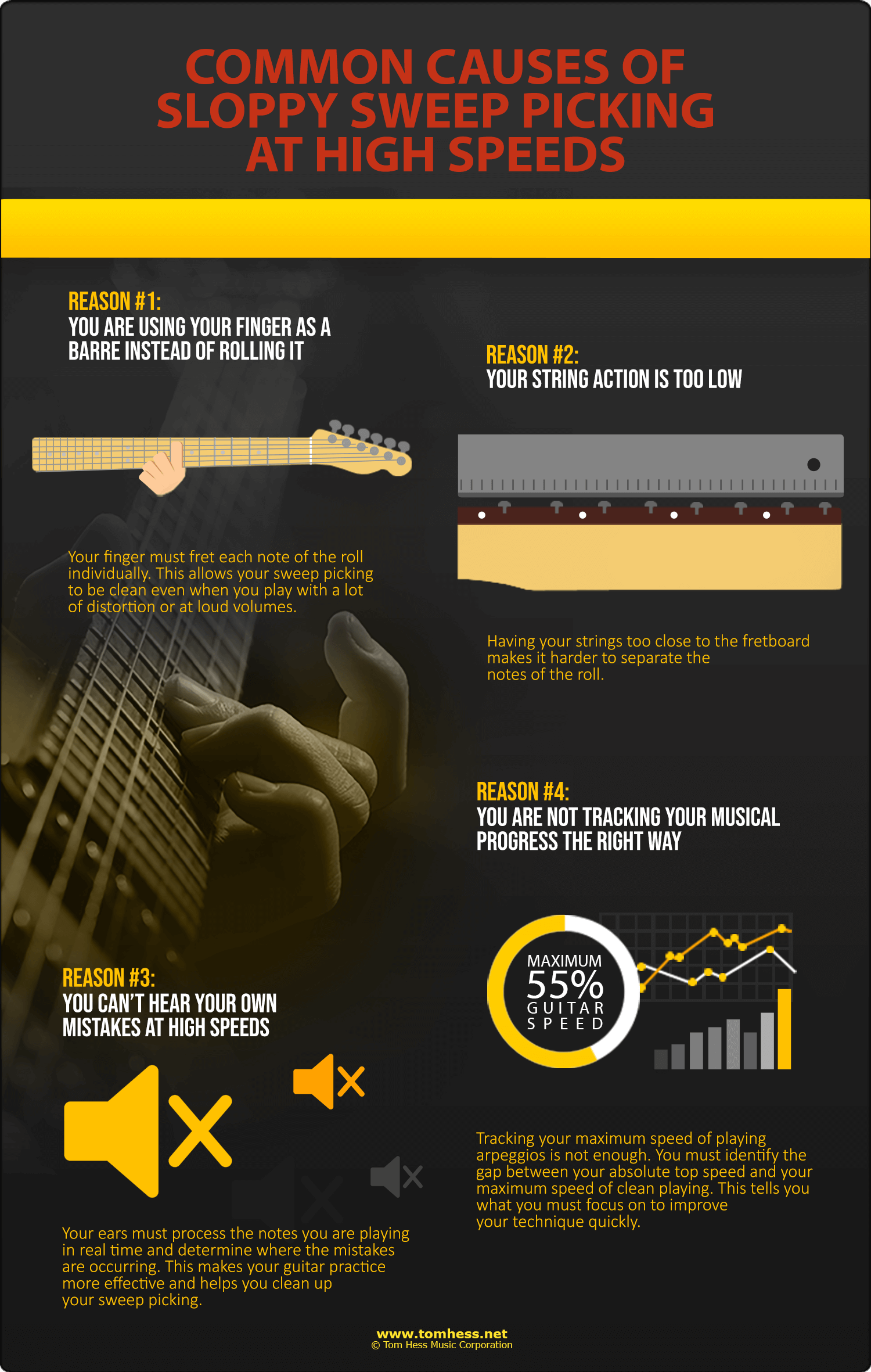How To Play 2-String Sweep Arpeggios And Improve Your Sweep Picking Guitar Technique

EMAIL TO GET ACCESS
By submitting your info, you agree to send it to Tom Hess Music Corporation who will process and use it according to their privacy policy.
One of the best ways to add more speed to your sweep picking guitar licks is...
... to play 2-string sweep arpeggios.
Why 2-string sweep arpeggios specifically?
Answer:
2-string sweep arpeggios bring together all of the simplest and most fun elements of sweep picking that make this guitar technique so easy to build speed with...
... while reducing the 2-hand synchronization demands for both hands.
(I.e. the thing that makes sweep picking guitar licks so hard to play for many guitar players.)

EMAIL TO GET ACCESS
By submitting your info, you agree to send it to Tom Hess Music Corporation who will process and use it according to their privacy policy.
And in this sweep picking article...
I lay out some of my best sweep picking tips that help you shred up and down the guitar with 2-string sweep arpeggios.
(While also getting faster with guitar licks that rely on other guitar techniques).
Ready to have fun and get faster with guitar arpeggios?
To begin...
Watch the video below that shows you cool and fun 2-string sweep arpeggios and how to play them fast and clean on guitar:
Now that you know the basics of playing fast sweep picking guitar licks, let’s go deeper.
Here are 5 more tips for playing guitar arpeggios, faster, cleaner and more creatively:
Guitar Arpeggio Tip #1: Combine Sweep Picking With Tremolo
This is – hands down – one of the best ways to integrate the guitar technique of sweep picking into your guitar licks.
Plus, it helps you to easily clean up sloppy guitar arpeggios too.
All you do is sweep pick up to any note in a guitar arpeggio and stop on it using tremolo. Then, return back to the starting note (using sweep picking)... and keep going like this for as long as you want. You can sweep up to and do tremolo on different notes in the guitar arpeggio each time (or sweep up to the same note several times). Up to you.
This sweep picking variation makes your guitar arpeggios sound very aggressive and, as such, make for very aggressive-sounding guitar licks that sound great in rock and metal lead guitar licks and solos.
But, perhaps even more importantly, this guitar technique (of combining sweep picking and tremolo picking) is a great way to train your 2-hand synchronization that lets you play more advanced guitar licks and solos.
(Plus, it makes it easy to tell when your sweep picking is very clean. If the notes leading up to the tremolo picked notes are clean and there is no noise around the tremolo note – you are playing very cleanly.)
Watch this video to see what I mean:
Question: “Tom Hess, can you really use tremolo picking even on 2-string sweep arpeggios?”
Answer: Yep. Of course. You do sweep picking (and combine sweep picking with tremolo) the same exact way, whether you are playing a 2-string, 3-string, 4-string, 5-string or 6-string (or more) guitar arpeggio.
The size of the motion in your sweep picking technique may be a little bit smaller...
But the principle is exactly the same.
Question: “Tom Hess, should I practice tremolo picking to the metronome?”
Answer: No. Go by feel and play these guitar licks (that combine sweep picking with tremolo on guitar arpeggios) in free time.
Likewise, don’t count your pick strokes. Go by feel here and you will have a much easier time playing sweep picking guitar licks that use this idea.
Guitar Arpeggio Tip #2: Master Finger Rolling
What is finger rolling?
It’s a guitar technique (that often comes up in guitar licks that use sweep picking) where you play several notes on the same frets, across different strings – using the same finger.
Many guitar players (even those who pick lightning fast and clean and can play lots of advanced guitar techniques) struggle to do finger rolling well.
And when it comes to sweep picking, those guitar players often avoid guitar arpeggios that contain finger rolling.
But when you learn this technique the right way?
Then you can achieve speeds that are nearly impossible to reach any other way.

Here is how to practice finger rolling when you are learning sweep picking arpeggios:
Step 1: Put your finger on the 10th fret of the D string. Fret the note using the fingertip of your index finger (exactly as you would play any other note).
Step 2: Collapse the knuckle by bending the finger backwards, so it looks a little bit like a banana and use the underside of your index finger to fret the G string. In the same motion, the tip of your index finger should release the D string.
Doing this transition smoothly ensures that the strings (G and D) don’t ring together and you hear each note of the roll separately.
Step 3 (optional & not applicable here since we are mainly talking about 2-string sweep arpeggios, but it applies when you move beyond 2-string sweep arpeggios to do sweep picking on 3 and more strings): rock your wrist backwards to collapse the index finger knuckle even more and fret the 3rd note of the roll on the B string.
Step 4: reverse steps 2 and 3 to arrive to the starting note on the D string.
Watch this video to see an illustration of this process in action:
Guitar Arpeggio Tip #3: Keep Hammer Ons And Pull Offs At The Same Speed As Picked Notes
A common mistake guitarists make when working on their guitar arpeggios is...
They rush the hammer ons and pull offs that (often) happen on the lowest and highest notes of the many sweep picking guitar licks.
And if you make this mistake?
Your playing, unfortunately, sounds amateur. Not to mention, guitar arpeggios now contain several different note values.
And it’s very hard to speed up something like that.
What is the solution?
First, simply practice making all the notes in your sweep picking guitar licks last the same duration.
You can do this simply by playing your guitar arpeggios as quarter notes to the metronome (one note per click).
If you are playing along with the metronome, it becomes much easier to control this aspect of your guitar technique. And once you get the hang of it, you’ll be able to keep the timing of your guitar arpeggios consistent at all tempos.
Watch this video that shows me training a student through refining this aspect of his sweep picking:
And fortunately...
Playing 2-string sweep arpeggios is an absolutely awesome way to refine this area of your guitar technique.
Why?
Because, unlike 3, 4 or 5-string arpeggios, there is a much higher ratio between hammer ons/pull offs and picked notes in 2-string sweep arpeggios specifically.
This makes it much easier to keep the timing of the notes balanced vs. the timing on those arpeggios that only have hammer ons and pull offs come up once in a while.
Question: “Tom Hess, should I practice my guitar arpeggios (such as the 2-string sweep arpeggios) with a clean tone or with distortion?”
Answer: practice sweep picking with distortion. Why do it this way? Because this makes any sloppy string noises (as well as noises from the notes bleeding together) much easier to notice and fix. Clean tone doesn't do that. Contrary to popular belief, clean tone is the tone that ‘masks’ (most) mistakes – not distortion. So, don’t use it for practicing your guitar arpeggio licks.
Guitar Arpeggio Tip #4: Connect Arpeggio Inversions Together
One of the common mistakes guitarists make when learning sweep picking (that sounds especially bad when you are playing 2-string sweep arpeggios) is...
Playing guitar arpeggios in only one position on guitar.
Fact is: guitar arpeggios (including, of course, 2-string sweep arpeggios), like all chords, can be played in several inversions.
For example: a simple major or minor triad guitar arpeggio can be played in root position (where the root of the chord is the lowest-sounding note)...
First inversion – where the 3rd of the chord is the lowest-sounding note...
Or 2nd inversion – where the 5th of the chord is the lowest-sounding note.
And when it comes to creating sweep picking guitar licks, there are 3 fingering shapes to learn that allow you to play triad guitar arpeggios all over the neck.
This is where the fun really starts.
Alas, many guitarists never learn the guitar arpeggio shapes for each inversion of the major/minor arpeggios.
Or, if they do – they don’t understand how they snap together and allow you to play awesome guitar arpeggio licks that cover the entire fretboard.
But those who learn how to connect guitar arpeggio inversions together are in for a world of fun when playing sweep picking guitar licks (even without playing all that fast).
Watch this video that shows you how to use the sweep picking guitar technique more creatively:
Question: “Tom Hess, do inversion patterns exist even for 2-string sweep arpeggios?”
Answer: Yes, of course. Inversions exist for all arpeggios, because all arpeggios are chords (this includes 2-string sweep arpeggios).
The only caveat is, because 2-string sweep arpeggios only cover 2 strings...
Your fretting hand needs to do a lot more position shifting vs. 5-6-string guitar arpeggios that allow you to sweep pick through a lot of notes without moving your arm.
But inversion shapes for 2-string sweep arpeggios work the same as inversion shapes for every other kind of guitar arpeggio.
Guitar Arpeggio Tip #5: Practice 7th Chords, Not Just Triads
Believe it or not...
When it comes to sweep picking, some 7th chord arpeggios are quite a bit easier to play than triads.
“How in the world can that be”, you ask?
Simple:
Even though 7th chord guitar arpeggios may be a bit more involved ‘musically’ – the physical motions your hands make for each arpeggio are much simpler to do than the motions for the major and minor triad sweep picking shapes.
(If this surprises you, remember how torturously hard the “simple” open C major and F major barre chord shapes were when you were a beginner? Yeah... and those chords are simple major triads too. Just because something may be ‘musically’ simple doesn't mean it’s also guaranteed to be physically easy to play... and vice versa.)
Here is an example of how simple 7th chord guitar arpeggios can be to play fast:
And here is a bonus tip for improving your guitar technique and building more speed with your sweep picking guitar licks:
Use speed bursts.
What are speed bursts?
It’s where you deliberately play guitar arpeggios a bit faster than your top speed, but you do it via short bursts of notes.
Doing this trains your mind to hear and feel the notes at speeds beyond what you are used to...
It trains your hands to stay relaxed as you learn to play faster.
What makes speed bursts so effective is: a ‘burst’ can be just a few notes long. This makes it easy to hit guitar speeds you previously may have thought were impossible for you.
And as you build comfort and confidence at the new (faster) tempo, you can make the burst longer gradually begin playing more notes at the higher speed.
This video shows how to practice sweep picking using speed bursts.
Now that you know what goes into building speed with 2-string sweep arpeggios, the next step is to learn how to create cool guitar arpeggio licks, so you can use your increased sweep picking speed to create awesome arpeggio guitar licks and guitar solos. I show you how in my free eGuide: Endless Killer Arpeggio Guitar Licks. Download it today and discover the secrets to playing awesome sweep picking guitar licks most guitarists will never know.


Transform your guitar playing quickly by studying with the best rock and metal guitar teacher online.

